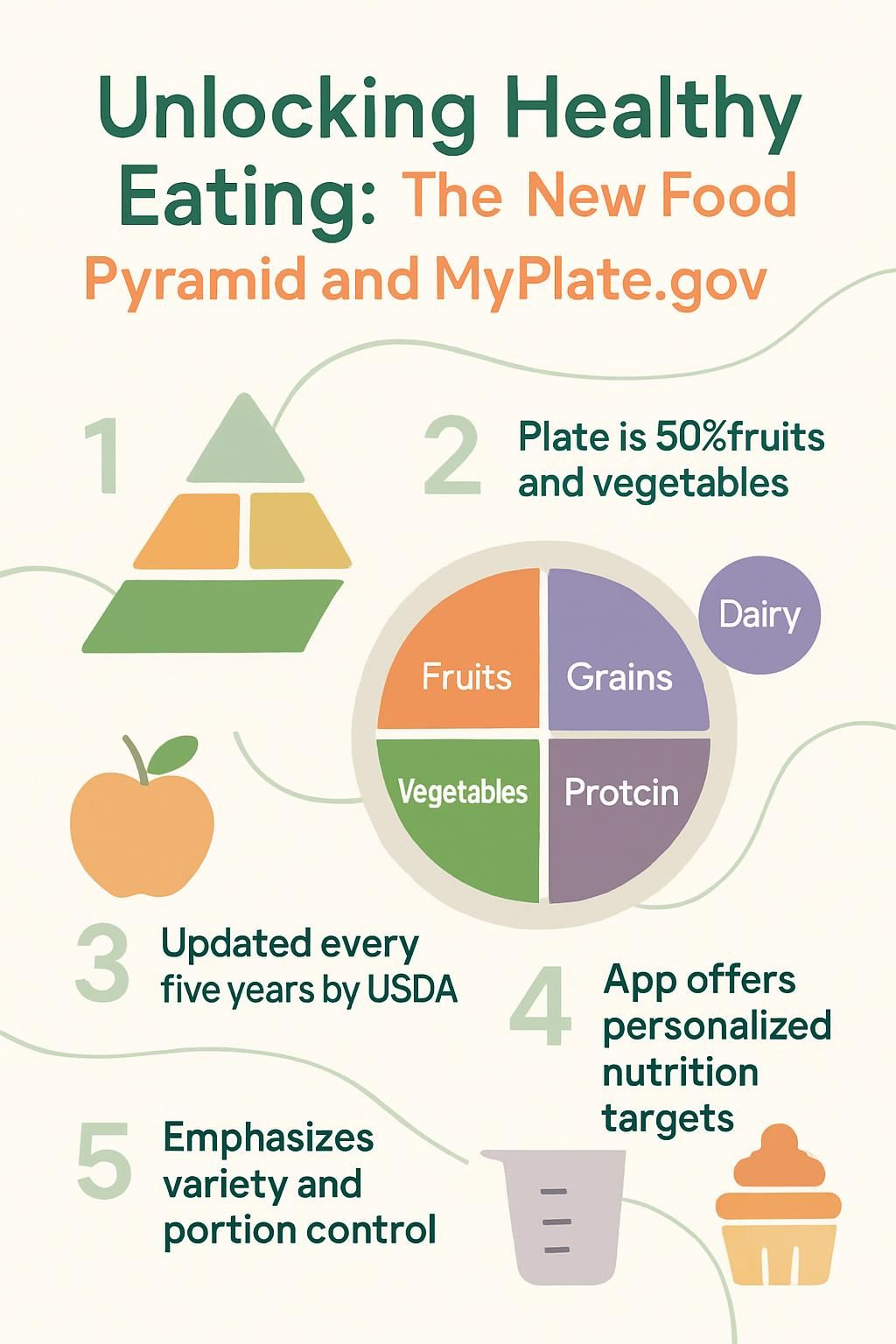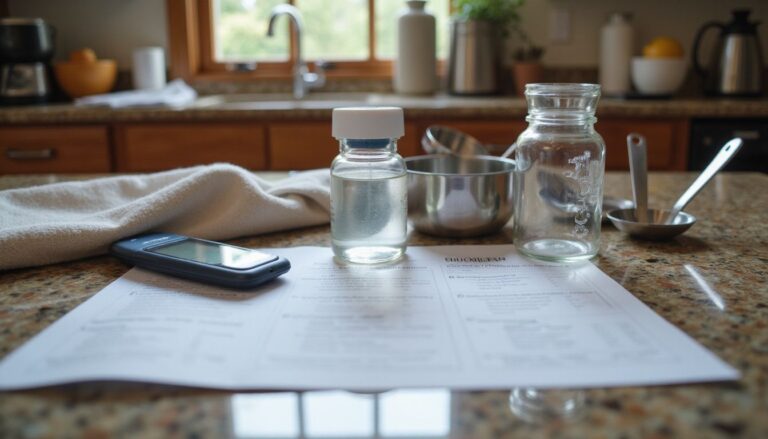Unlocking Healthy Eating: The New Food Pyramid And MyPlate.gov Guide
Our Nutrition Assistant AI Suite will transform your body. You will lose fat, get toned, and build muscle. Gain confidence and optimal health.
Healthy eating can feel confusing with so many nutrition messages. MyPlate from the United States Department of Agriculture replaced the old food pyramid to give a simpler path to balanced meals and better nutrition.
This guide explains how MyPlate.gov and the New Food Pyramid ideas help you plan everyday meals using clear steps, visual tools, and science-based tips. Use it to make smart, budget-friendly choices today.
Key Takeaways
- MyPlate, launched by the USDA in 2011, replaced the food pyramid with a clearer plate visual based on five food groups.
- The plate shows 50% fruits and vegetables, 25% whole grains, and 25% lean protein, with dairy on the side.
- Guidance updates every five years from USDA and HHS experts. It encourages healthy oils like olive oil and nuts, and limiting saturated fat.
- The Start Simple with MyPlate app and the MyPlate.gov Plan set personal targets using your age, sex, height, weight, and activity level.
- MyPlate stresses variety and portions to support long-term health, and adapts to different diets, ages, and health needs.

Understanding the New Food Pyramid and MyPlate

The new food pyramid concepts and MyPlate come from the USDA and the Department of Health and Human Services. These tools turn complex dietary guidelines into practical steps for daily meals.
How has the Food Pyramid evolved over time?
In 1992, the United States introduced the first food guide pyramid. It placed grains at the base and suggested more bread, rice, and pasta than other foods.
Fruits, vegetables, dairy, meats, and fats each had a layer. The model warned against fat in general, without separating healthy fats from less healthy ones.
Over time, research from places like Harvard University showed the pyramid often confused portions and balance. Many people were unsure how much to eat from each group.
In 2011, MyPlate replaced the food pyramid. The plate has five clear parts: fruits, vegetables, grains with an emphasis on whole grains, protein foods such as beans, tofu, seafood, or lean meats, and dairy like milk or yogurt on the side.
Today, guidance supports unsaturated fats, which are fats that stay liquid at room temperature, from nuts, seeds, and olive oil. It also suggests limiting saturated fat to support heart health and healthy cholesterol levels.
The update makes it easier to personalize meals to your needs. Experts from USDA and HHS review and update the Dietary Guidelines for Americans every five years.
“The new visual puts fruits and vegetables at the center of your meal.”
Curious how MyPlate works in daily eating?
What is MyPlate and how does it work?
MyPlate, created in 2011 by the USDA, replaced the old food pyramid with a simple plate picture. It shows how to split a standard dinner plate into food groups without complex math.
Half your plate is fruits and vegetables. One quarter is whole grains or other complex carbohydrates like brown rice or whole wheat pasta. The last quarter is protein, such as lean meats, fish, beans, lentils, or tofu.
A small serving of dairy sits next to the plate. Healthy fats from olive oil, nuts, and seeds can be part of meals in modest amounts.
The MyPlate Plan at MyPlate.gov sets personal targets using your age, sex, height, weight, and activity level. You can focus on simple portions instead of counting calories or grams.
I used the Start Simple with MyPlate app to plan family meals on a budget. The app made it easy to pick better options at home and when ordering out.
The approach works for many eating patterns, including plant-based and low-fat styles. It adapts for infants, kids, teens, adults, and older adults.
Detailed Guide to MyPlate. gov
MyPlate.gov explains balanced meals in plain language. It highlights the five food groups and offers tools to set goals and track healthy eating habits.
What are the essential food groups in MyPlate?
Choosing healthy foods is simpler with MyPlate. It organizes eating into five essential groups.
- Fruits fill about one quarter of your plate. Fresh, frozen, canned in juice, or dried options all count. Aim for fruit daily for vitamins and fiber.
- Vegetables cover another quarter. Include leafy greens, carrots, tomatoes, peas, and broccoli. These support heart health and help with weight control.
- Grains take up one quarter. Make at least half your grains whole, like oatmeal, brown rice, or whole wheat bread, for steady energy.
- Protein foods fill the last quarter. Choose lean meats, poultry, fish, eggs, beans, peas, tofu, nuts, and seeds to build and repair body tissue.
- Dairy appears as a cup on the side. Low-fat milk or yogurt can help you meet calcium goals. People with dairy needs can use fortified alternatives.
Getting these groups in the right amounts supports strong eating habits. Next, see how to size portions using MyPlate.
How can I determine proper portion sizes?
Use a standard dinner plate for an easy visual. Fill half with fruits and vegetables, as Harvard’s School of Public Health often advises in its plate models.
Then save one quarter for whole grains or other complex carbs like brown rice or beans. The last quarter is for lean proteins such as chicken, fish, tofu, or nuts.
For mixed dishes like casseroles or stir-fries, think about the main ingredients and split them into the four parts. For packaged foods, check the Nutrition Facts Label to match serving sizes and calories with your goals.
With practice at home, and with recipes in MyPlate Kitchen, these habits become second nature. Most people find they eat healthier while sticking to a budget.
How does MyPlate promote balanced nutrition?
Once you know your portions, balance becomes easier. MyPlate divides each meal into fruits, vegetables, grains, and protein, with dairy on the side.
Filling half your plate with colorful produce supports gut health and fights inflammation. It also helps regulate cholesterol and supports your immune system.
Whole grains and lean proteins give longer lasting energy and building blocks for muscle and tissue repair. Healthy fats help your body absorb vitamins A, D, E, and K and support heart health.
This flexible design lets you enjoy foods you love while keeping meals balanced. It also nudges you to check your fiber and protein each time you eat.
Many parents use MyPlate to teach kids how to build a healthy meal. The simple picture becomes a quick checklist at the table.
Comparing the Old Food Pyramid with MyPlate
The shift from the pyramid to the plate makes healthy eating easier to picture. A plate feels like a real meal plan, not just a chart.
What are the benefits of MyPlate’s simplified design?
MyPlate’s clean design helps you build a balanced meal at a glance. The four plate sections, plus dairy on the side, show how much space each group should take.
There is no need to memorize complex serving charts from the old food pyramid. You can use the picture to guide choices at home, school, and restaurants.
Parents and kids often say the plate is less confusing. I struggled with the pyramid in school, yet MyPlate made weekly meal planning much easier.
How does MyPlate emphasize fruits and vegetables?
Half of the plate is fruits and vegetables, which makes produce the star. Choose a mix of colors like spinach, broccoli, tomatoes, cucumbers, berries, and apples.
Many people in the United States fall short on produce. The MyPlate image is a daily reminder to add non-starchy vegetables and fresh fruit to meals and snacks.
Eating a variety of whole plant foods can lower the risk of heart disease and improve digestion due to fiber. Try to cover your plate with several colors since each color often brings different nutrients.
When I used MyPlate at home, my family reached for more fresh options without pushing. Next, see how healthy fats fit on your plate.
How are healthy fats and oils included in MyPlate?
Healthy fats now have a place in daily meals. Add olive oil to salads, spread avocado on whole-grain toast, or snack on nuts and seeds like almonds and sunflower seeds.
These fats support your heart, hormones, and vitamin absorption. MyPlate.gov suggests choosing unsaturated fats and avoiding trans fats for better heart health.
There is no separate fats group on the plate, so you weave them into meals. For example, I add sliced avocado to lunch or a small handful of nuts as a snack.
Current science, including research from university nutrition programs, supports plant-based and healthy animal fats in sensible amounts.
How MyPlate Enhances Healthy Eating Practices
Think of MyPlate as a daily checklist you can use at breakfast, lunch, and dinner.
How does MyPlate encourage diverse food choices?
MyPlate supports many cultural and dietary preferences. It helps you break dishes like soups, stews, or rice and beans into the food groups.
The plan works for omnivores and plant-based eaters. Choose a variety within each group across the week. For instance, try a different fruit or a new nut each day.
This flexibility makes room for familiar family foods and new flavors. Online resources offer ideas that fit many traditions.
Why focus on whole grains and lean proteins?
Whole grains and lean proteins give steady energy and strong nutrition. Aim for at least half your grains to be whole, such as brown rice, oats, or whole wheat bread.
These choices bring fiber, vitamins, and minerals that help control blood sugar. Lean proteins like chicken, fish, eggs, beans, and tofu supply amino acids for muscle and skin.
Protein also helps immune function and recovery after exercise. Pair whole grains with protein to feel full longer without extra sugar or unhealthy fats.
Swapping white bread for whole wheat gave me steadier energy for schoolwork and sports.
What are effective portion management strategies?
Portion control supports balanced meals and personal goals. MyPlate turns this into clear steps.
- Use the MyPlate split: half fruits and vegetables, one quarter grains or carbs, one quarter protein.
- Check the Nutrition Facts Label to find serving size, calories, and key nutrients.
- Pick smaller plates or bowls to reduce overeating large portions.
- Measure snacks or ingredients with cups or a kitchen scale to avoid accidental overserving.
- Load up on fiber-rich foods like fruits, vegetables, and whole grains for fullness.
- Use the MyPlate.gov Plan to set targets for each food group for your age and activity.
- Plan mixed dishes so that vegetables make up half of what is served.
- Limit added fats. Use healthy oils in small amounts and follow label serving sizes.
- Use MyPlate.gov self-check tools to review your daily balance.
- Split large restaurant meals or take home leftovers to stay within portions.
- Pay attention to hunger and fullness cues instead of always clearing your plate.
These steps work for many ages and diets and can improve long-term nutrition outcomes.
Advantages of Adopting MyPlate
MyPlate turns dietary guidelines into clear actions you can take today.
What dietary guidelines does MyPlate provide?
MyPlate.gov gives practical, research-based advice for healthy eating patterns across life stages.
- Fill half your plate with fruits and vegetables to boost fiber and vitamins.
- Make at least half your grains whole, such as brown rice or whole wheat bread.
- Vary protein sources, including seafood, poultry, eggs, beans, peas, nuts, and seeds.
- Include low-fat or fat-free dairy like milk or yogurt, or use fortified alternatives.
- Choose nutrient-dense foods, which means foods packed with nutrients for the calories, and limit added sugars, sodium, and saturated fat.
- Use the plate image to keep portions in check at each meal.
- Personalize your plan with MyPlate tools and the Start Simple app.
- Build healthy patterns over time. Consistency matters more than any single meal.
These steps reflect the Dietary Guidelines for Americans, updated every five years.
How can MyPlate help with personal nutrition goals?
The MyPlate Plan calculator at MyPlate.gov estimates daily calorie needs and sets food group targets. It uses your age, sex, height, weight, and activity level.
You might increase whole grains to boost fiber or adjust portions to manage energy. Many users report better digestion and more steady energy after following their plan.
Resources are available in English and Spanish, which helps more families put the guidance into practice. For medical concerns, seek advice from a healthcare professional or a registered dietitian.
What tips does MyPlate offer for economical eating?
Healthy eating can fit your budget. MyPlate.gov provides practical tools and recipes for affordable meals.
- Use the Shop Simple with MyPlate tool to find local deals and budget-friendly picks.
- Rely on staples like oats, beans, and brown rice. They are low cost and nutrient dense.
- Buy seasonal produce for better prices and flavor, like berries in summer.
- Keep frozen vegetables, canned beans, nuts, and berries for value and nutrition.
- Plan meals and snacks to cut food waste and limit impulse buys.
- Cook once and use leftovers in new dishes to stretch your budget.
- Buy in bulk for items like grains and legumes when storage allows.
- The Start Simple app offers low-cost meal ideas. A quick veggie stir-fry saved me time and money.
- Choose economical proteins, such as eggs or canned fish, to stay balanced.
- Compare unit prices. Shop Simple with MyPlate makes smart choices faster.
Customizing MyPlate for Individual Requirements
Personalizing your plate helps it fit real life, including health conditions, culture, and taste.
How to adjust MyPlate for specific health conditions?
Smart changes can keep meals safe and satisfying. Use food labels and professional advice to guide your choices.
- Talk with a clinician or registered dietitian before making changes.
- If managing high blood pressure, choose items with less than 140 mg of sodium per serving.
- For diabetes, track carbohydrates. Pick whole grains and non-starchy vegetables, and limit added sugars based on your care plan.
- To manage cholesterol, use healthy fats like olive oil, nuts, and avocado, and reduce saturated fat.
- For lactose intolerance, use lactose-free milk or fortified soy drinks to meet calcium needs.
- Boost fiber with beans and vegetables for digestive and heart health.
- For kidney concerns, include more plant proteins like beans and tofu, and follow medical advice.
- Adjust fruits and vegetables if you have allergies or sensitivities. Fresh, frozen, or canned can all work.
- Use MyPlate visual cues to keep portions steady for weight goals.
- Review your plan often with your care team since needs can change.
How to tailor MyPlate for plant-based diets?
Vegetarian and vegan patterns fit easily into MyPlate with a few swaps.
- Fill the protein quarter with beans, lentils, tofu, tempeh, or edamame for protein and iron.
- Choose whole grains like brown rice, quinoa, oats, and 100% whole wheat bread for fiber.
- Keep half the plate fruits and vegetables for vitamins and minerals.
- Use calcium-fortified soy milk or fortified almond milk if avoiding dairy.
- Include healthy fats from avocado, nuts, seeds, and olive oil in small amounts.
- Check labels for vitamin B12, iron, iodine, and zinc in fortified foods.
- Limit highly processed meat substitutes that can be high in sodium and saturated fat.
- Use MyPlate.gov vegetarian tips for evidence-based guidance for every age group.
I followed this approach during my shift to plant-focused eating. Using the MyPlate picture made planning simple and helped me meet my nutrition needs week after week.
How does MyPlate apply to different age groups?
The MyPlate Plan adapts to age and activity level. It provides tailored targets for each person in your household.
Children need smaller portions, plus extra focus on fruits, vegetables, whole grains, and dairy or fortified alternatives. Adults need portions that match daily energy needs and support long-term health.
Older adults often need fewer calories yet more nutrient-dense foods like lean protein and high-fiber choices. The online calculator shows differences in targets for a growing child, a sedentary adult, or an older adult recovering from illness.
As a parent, I saw how my son’s plan called for more whole grains than mine. We used that insight to build plates that fit both of us.
Practical Ways to Implement MyPlate Daily
Small, steady steps add up. Use these ideas to turn MyPlate into daily action.
How to design meals using MyPlate?
MyPlate makes meal design visual and quick. Follow these steps for balanced plates.
- Fill half your plate with fruits and vegetables. Use many colors for a range of nutrients.
- Reserve one quarter for whole grains or complex carbs, like brown rice, whole wheat pasta, or quinoa.
- Use the last quarter for lean proteins, such as chicken, fish, tofu, or beans.
- Add a source of healthy fat, like nuts, seeds, or a drizzle of olive oil.
- Explore MyPlate.gov recipes for ways to combine the five groups.
- Break down casseroles and mixed bowls into their MyPlate parts.
- Use a 9-inch plate to prevent oversized servings.
- Choose water or low-fat milk to limit added sugars.
- Adjust your plate for health conditions, plant-based choices, or different ages.
- Apply the method at home and while eating out. Ask for whole grains, grilled proteins, and extra vegetables.
- My quick win: packing lunch bowls with the MyPlate split gave me steady midday energy.
What should I look for when shopping for balanced diets?
Smart shopping makes healthy eating easier and cheaper. Use this checklist in the store.
- Choose foods high in fiber, vitamin D, calcium, iron, and potassium, nutrients many people lack.
- Limit saturated fat, sodium, and added sugars. These raise long-term health risks.
- Compare package serving sizes with your MyPlate targets to control portions.
- Pick whole-grain breads and cereals instead of refined grains for heart and gut health.
- Select lean proteins like chicken breast or beans instead of fatty meats.
- Add a variety of colorful produce for vitamins, minerals, and antioxidants.
- Use MyPlate infographics or mobile apps as quick guides in the aisle.
- Check unit prices to find good value. Shop Simple with MyPlate can highlight affordable choices.
- Read ingredient lists. Look for whole grains and healthy oils near the top.
- Buy fortified foods if you need extra vitamin D or iron, based on your goals or your clinician’s advice.
- Bring a list based on MyPlate food groups to stay focused and avoid impulse buys.
Growing up, my family used a MyPlate shopping list. Those simple steps kept our cart full of foods that helped us feel our best.
How to make healthy choices when eating out?
Restaurant meals can still match the MyPlate model. Use these quick moves at the table.
- Pick meals with generous fruits and vegetables, such as salads and vegetable sides.
- Swap in whole grains like brown rice or whole wheat bread for extra fiber.
- Choose lean proteins, including grilled chicken, fish, tofu, or beans.
- Favor healthy fats like olive oil or avocado. Skip deep-fried items.
- Check menu nutrition info if available, especially sodium and calories.
- Ask for sauces and dressings on the side to control portions.
- Drink water or unsweetened beverages instead of sugary drinks.
- Use the plate visual to estimate portions. Aim for half produce.
- Share large entrees or box half before you start eating.
- Request extra vegetables in place of fries or white rice.
- Preview menus online to compare options and prices with Shop Simple tips.
Technological Support for MyPlate Usage
Technology can turn good intentions into daily habits. Let your phone do some of the work.
How to use the Start Simple with MyPlate app?
Download the Start Simple with MyPlate app from your app store. Create your profile, then set daily or weekly targets for fruits, vegetables, grains, protein, and dairy.
The app suggests simple meals that match the MyPlate split. Turn on reminders to nudge you through the day.
Log your foods and track progress. Short motivational notes appear as you complete goals. Tracking vegetable servings helped me make colorful salads at lunch more often.
Can I integrate MyPlate with Alexa?
Yes. Connect MyPlate with Alexa-enabled devices for hands-free support.
Use voice commands to get meal ideas, healthy tips, and MyPlate recipes. You can also set reminders for produce intake or water.
After linking accounts, say, “Alexa, open MyPlate” to get quick help in the kitchen.
How can Shop Simple with MyPlate help save money?
Shop Simple with MyPlate is a digital tool that finds budget-friendly, healthy foods near you. It offers recipes that use lower-cost, nutrient-dense ingredients.
You can plan meals around weekly deals and filter for affordable produce and lean proteins. All ideas align with MyPlate’s balanced approach.
I reduced my grocery bill by about 15% after planning with the tool. The seasonal lists made it easy to switch to lower-priced items without losing nutrition.
Exploring Other Nutritional Approaches
Other evidence-based patterns also support a healthy diet. Choose the one that fits your lifestyle, then apply MyPlate principles for balance.
What are the benefits of the Mediterranean Diet?
The Mediterranean pattern centers on fruits, vegetables, whole grains, healthy oils like olive oil, and lean proteins such as fish and poultry. Studies link it to a lower risk of heart disease, better weight control, and less inflammation.
Some research reports up to a 30% lower risk of heart events compared with typical Western diets [2]. Many people feel more satisfied due to fiber and healthy fats.
MyPlate.gov recognizes this pattern as a healthy option. It fits neatly with the plate method for portions.
How does the DASH Diet support cardiovascular health?
The DASH Diet, Dietary Approaches to Stop Hypertension, helps lower high blood pressure. It reduces sodium and raises intake of fruits, vegetables, whole grains, and low-fat dairy.
People who follow DASH can lower systolic blood pressure by as much as 11 points in studies [3]. Targets are usually less than 2,300 mg of sodium per day, and some benefit from 1,500 mg with guidance.
Combine DASH with MyPlate by choosing lean proteins, whole grains, and low-sodium options. Many clinicians recommend DASH for heart health.
What are the advantages of plant-based eating?
Plant-based eating focuses on whole grains, beans and lentils, fruits, and vegetables. It often lowers saturated fat and raises fiber, which supports heart health.
In one 2021 analysis from the American Heart Association, people who ate mostly plant foods had up to a 16% lower risk of heart disease [1]. These patterns can also help with weight management.
Some choose plant-based diets for environmental reasons. Reports from the UN Food and Agriculture Organization show producing plants usually uses fewer resources than raising animals [4].
MyPlate adapts easily to vegetarian or vegan eating. For example, swap dairy milk for fortified soy milk and use beans or tofu as your protein.
Correcting Popular Misconceptions about Nutrition
Separate facts from myths to make confident choices for your plate.
What are the truths about fats and carbohydrates?
Fats and carbs are not all the same. Healthy fats like olive oil, avocados, nuts, and seeds support brain function and vitamin absorption.
Complex carbohydrates, such as sweet potatoes, oats, and brown rice, digest slowly and keep blood sugar steadier. Quality matters more than sheer amount.
Older guidelines often discouraged all fat. MyPlate highlights the difference between healthy and less healthy types.
When I swapped refined bread for brown rice, my afternoon energy leveled out during classes and practice.
What should I know about processed foods?
Ultra-processed foods often contain excess sodium, added sugars, and saturated fat. The Nutrition Facts Label helps you spot these quickly.
Examples include sugary cereals, packaged snacks, and some frozen meals. A single frozen pizza can have more than 1,000 mg of sodium per serving.
The CDC reported that ultra-processed items made up about 57% of calories in the typical American diet in 2020 [5]. Focusing on whole foods like produce, lean proteins, and whole grains gives you more nutrients per bite.
Use labels to make informed choices. Shift your cart toward nutrient-dense options most of the time.
Conclusion
Choosing healthy foods gets easier with MyPlate.gov. The simple plate picture shows how much of each food group to include at meals.
Focus on fruits, vegetables, whole grains, lean protein, healthy fats, and dairy or fortified alternatives. Instead of counting every calorie, build balanced plates that fit your life.
Small changes add up to better energy and long-term health. Use MyPlate as your everyday guide to healthy eating and smart nutrition choices.
FAQs
1. What is the new food pyramid and how does it differ from MyPlate.gov?
The updated food pyramid, now called MyPlate.gov, uses a plate graphic to show healthy eating patterns. It replaces the old pyramid with clear sections for fruits, vegetables, grains, protein foods like beans or chicken, and dairy such as milk or yogurt. This visual guide helps people plan balanced meals based on current nutrition science.
2. How can I use MyPlate.gov to improve my daily diet?
MyPlate.gov suggests filling half your plate with fruits and vegetables at each meal. The other half should include whole grains and lean proteins like eggs or fish. A small serving of low-fat dairy completes the meal. Following this model supports better health by encouraging variety and portion control.
3. Are there any statistics that support using MyPlate.gov for healthy eating?
Research from the Centers for Disease Control shows that only 10 percent of Americans eat enough vegetables each day while most eat too many refined grains and added sugars (CDC 2020). Studies link following MyPlate’s recommendations with lower risk of heart disease and obesity (USDA 2021).
4. Can you share a personal experience using these guides?
After switching to meals that follow the MyPlate pattern—such as grilled fish with brown rice and steamed broccoli—I noticed more energy during work hours and fewer cravings for snacks at night. Planning meals using these guides made grocery shopping easier since I focused on whole foods in each group.
Summary:
MyPlate.gov offers a simple way to build healthy meals using evidence-based guidelines. The approach encourages balance between fruits, vegetables, grains, proteins like tofu or turkey breast, and dairy products such as cheese or kefir. Research shows these habits support long-term wellness. Personal experience confirms that using these guides makes healthy eating easier each day.







